THE BOND BETWEEN CAMEL-DRIVER AND CAMEL
The camel-driver on march is an interesting subject
of study. There is between him and his beast of burden a bond of
affection hardly less strong than that which exists between the Arab
horseman and his steed. The camel is the essential of life in the sands.
Travel and trade are dependent upon him.
On march the camel goes best when his driver sings.
These songs, or chants,
(p255)
almost invariably concern the virtues of the ungainly but intrepid
beast. His praises are sounded in most extravagant terms, and the animal
seems to like it.
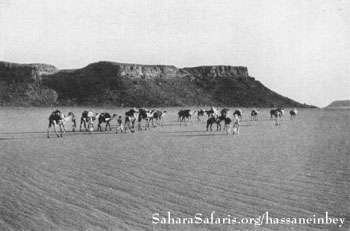
APPROACHING
THE HILLS OF OUENAT
Ouenat was found to be an oasis with 150
part-of-the-year inhabitants (see text, page 275) [photo page 256]
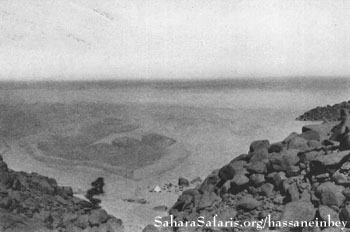
THE DESERT AS
SEEN FROM THE HILLS OF OUENAT
The white spot is the author's tent,
which was not often set up, as it was very difficult to raise (see text,
page 245) [photo page 256]
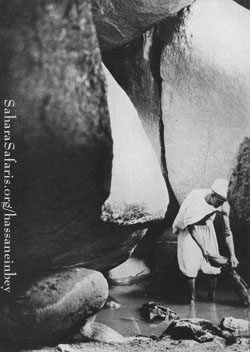
ONE OF THE
WELLS AT OUENAT
There are two types of wells known to
the desert—the ain, which is a natural spring, and the bir,
whose existence is usually indicated to the traveler by damp sand, where
he may dig and find water. These natural basins of Ouenat, which contain
rain water, are not, strictly speaking, of either type, but they are
called ains. [photo page 257]
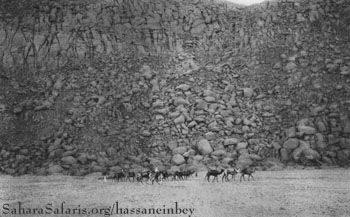
THE CARAVAN
APPROACHING THE OASIS OF THE OUENAT
The enormous boulders of the precipitous
cliff have been worn smooth by the sand-blasts of the desert (see text
page 275) [photo page 258]
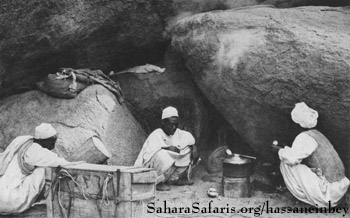
A CAVE
UTILIZED AS A KITCHEN FOR THE CARAVAN DURING ITS STAY IN THE OASIS OF
OUENAT
Beneath the shadow of these rocks the
members of the caravan found some relief from the blistering heat of the
outside world. [photo page 259]
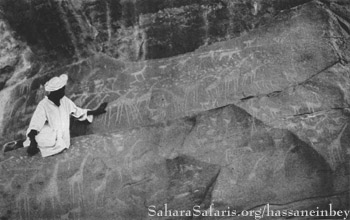
THE
MYSTERIOUS ROCK CARVINGS AT OUENAT
Hidden in the heart of this
hitherto-unknown oasis are these strange
pictographs. Who carved them
and when are questions yet to be answered by science, but there are
indications that they may antedate the Christian era (see text, page
276) [photo page 260]
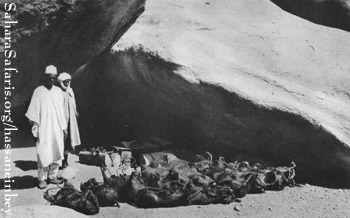
THE WATER
SUPPLY FOR THE CARAVAN
An average water-load for a camel on
march is four sheepskins, each containing six gallons. [photo page 261]
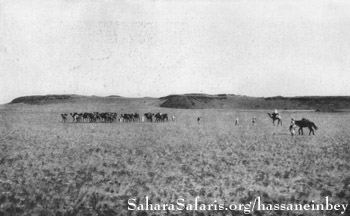
THE CARAVAN
APPROACHING ERDI: THE COUNTRY CHANGING FROM ARID DESERT TO A PLATEAU
COVERED WITH GRASS
This was the most interesting change
encountered in the Libyan Desert. It marks the line between the
waterless waste and country with sufficient grass for pasturage. Had the
expedition not come across this grass, the entire caravan would have
been lost [photo page 262]
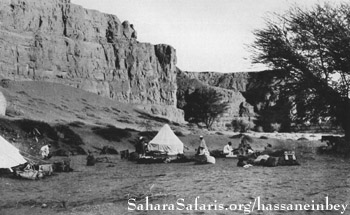
CAMPING IN
THE VALLEY OF ERDI AFTER AN 11-DAY TREK FROM THE OASIS OF OUENAT
The sheer walls inclosing this oasis are
of red rock, and the sands of the floor are likewise red. Note the
author's horse, Baraka, in the shade of the trees at the right. [photo
page 263]
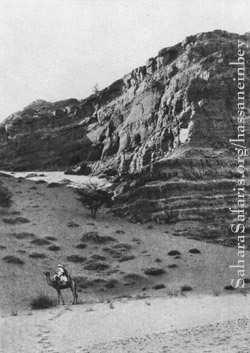
THROUGH THE
VALLEY OF ERDI
While there remained many miles of
travel for the expedition after reaching this valley, the long,
waterless desert treks were at an end. The march to El Obeid was by easy
stages, through fertile country, from village to village (see map, page
236). [photo page 264]
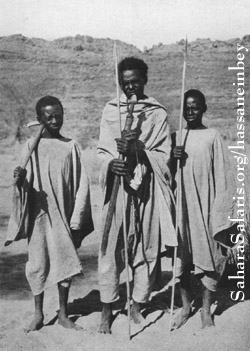
SONS OF GORAN
CHIEFS AT AGAH, BEYOND ERDI
One of the kindliest and most hospitable
natives encountered by Hassanein Bey south of Kufra was a chief of this
tribe residing in the Oasis of Ouenat. He was known as Sheik Herri, King
of Ouenat. [photo page 265]
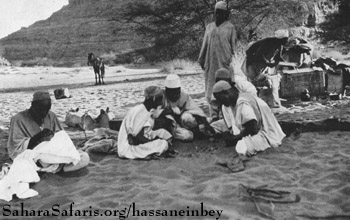
THE MEN OF
THE CARAVAN PLAYING DRAUGHTS ON THE SAND
The checkerboard is made by pressing
holes in the sand with the fingers. Black and white stones are used for
the "men." [photo page 266]
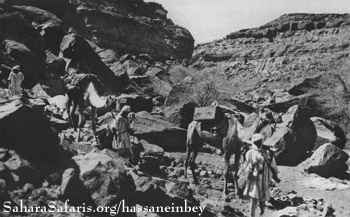
DIFFICULT
COUNTRY THROUGH WHICH THE CARAVAN PASSED BEYOND ERDI
This is the worst type of country
imaginable for both beasts and men, as the sharp stones cut the padded
feet of the camels as well as the thin-soled shoes of the men. Travel by
night over such land is practically impossible. [photo page 267]
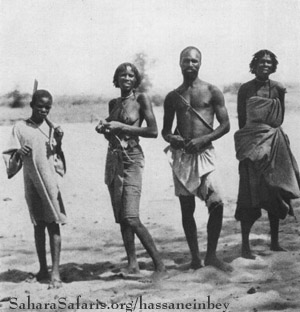
A BIDIAT
FAMILY
From right to left, the mother-in-law,
the husband, the wife, and the son. [photo page 268]
[photo]
(p256) [photo]
(p257) [photo]
(p258) [photo]
(p259) [photo]
(p260) [photo]
(p261) [photo]
(p262) [photo]
(p263) [photo]
(p264) [photo]
(p265) [photo]
(p266) [photo]
(p267)
The camel-driver knows his charge so well that he
is able instantly to identify the beast by its footprints in the sands;
and not only is he able to do this, but also to identify the son of that
camel; in other words, it would seem that each camel family has its own
footprint peculiarities.
The average animal will carry a burden of from 250
to 300 pounds, but it is the duty of the astute explorer to supervise
the loading at the beginning of each march, seeing always that the
camel, which carried a heavy load yesterday is given a light burden
to-day.
Where supplies are plentiful, the animals are given
grass and barley, but in desert trekking, when these are not obtainable,
they are fed twice a day on dates, a meal consisting of as much fruit as
can be gathered together twice in two hands. The animals are serviceable
up to 23 or 25 years of age and are valued at from $50 to $100.
It is recorded that, when water supplies have been
exhausted, caravan leaders
(p268) have slain their
weaker camels and the drivers have then extracted all the moisture
possible from the stomachs of the animals. In the final extremity, the
frothy pink blood has, in some instances, been drunk; but this practice
inevitably means the end, for such a draught is comparable to the
drinking of sea water by shipwrecked persons.
(p269)
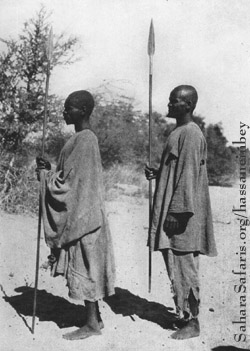
TWO BIDIAT
MEN
"The southern portion of the 1ibyan
Desert is inhabited by tribes of blacks—Tebu, Goran, and Bidiat—who are
rather more refined in features than the central African negroes" (see
text, page 234). [photo page 269]
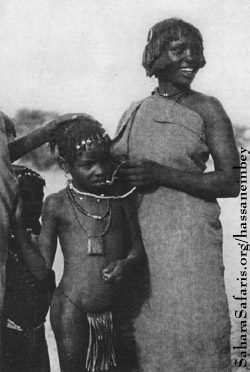
A BIDIAT GIRL
WITH HER SISTER
The child is wearing a macaroni
necklace. The author gave the natives macaroni to eat, but they quickly
converted it into "jewelry." [photo page 270]
In winter, in case of necessity, a camel in good
condition can go for 55 days without water; in summer, from 10 to 12
days is the limit.
If an animal becomes completely exhausted on a
trek, it must be killed. This is one the saddest experiences of the
desert, for a camel is really a member of a caravan and not merely a
beast of burden.
 
|
